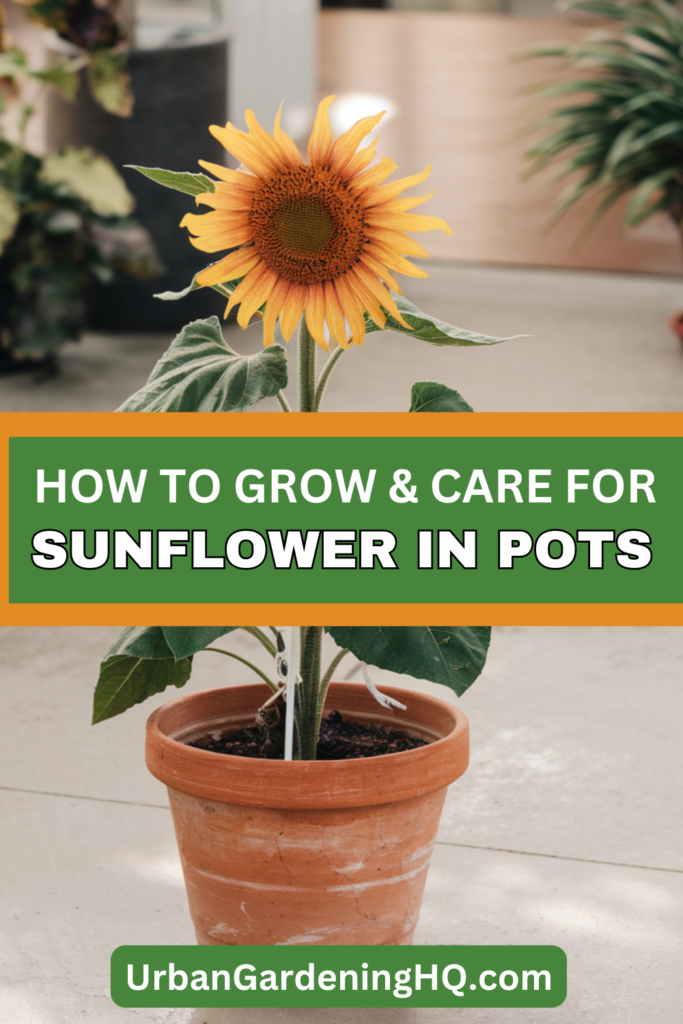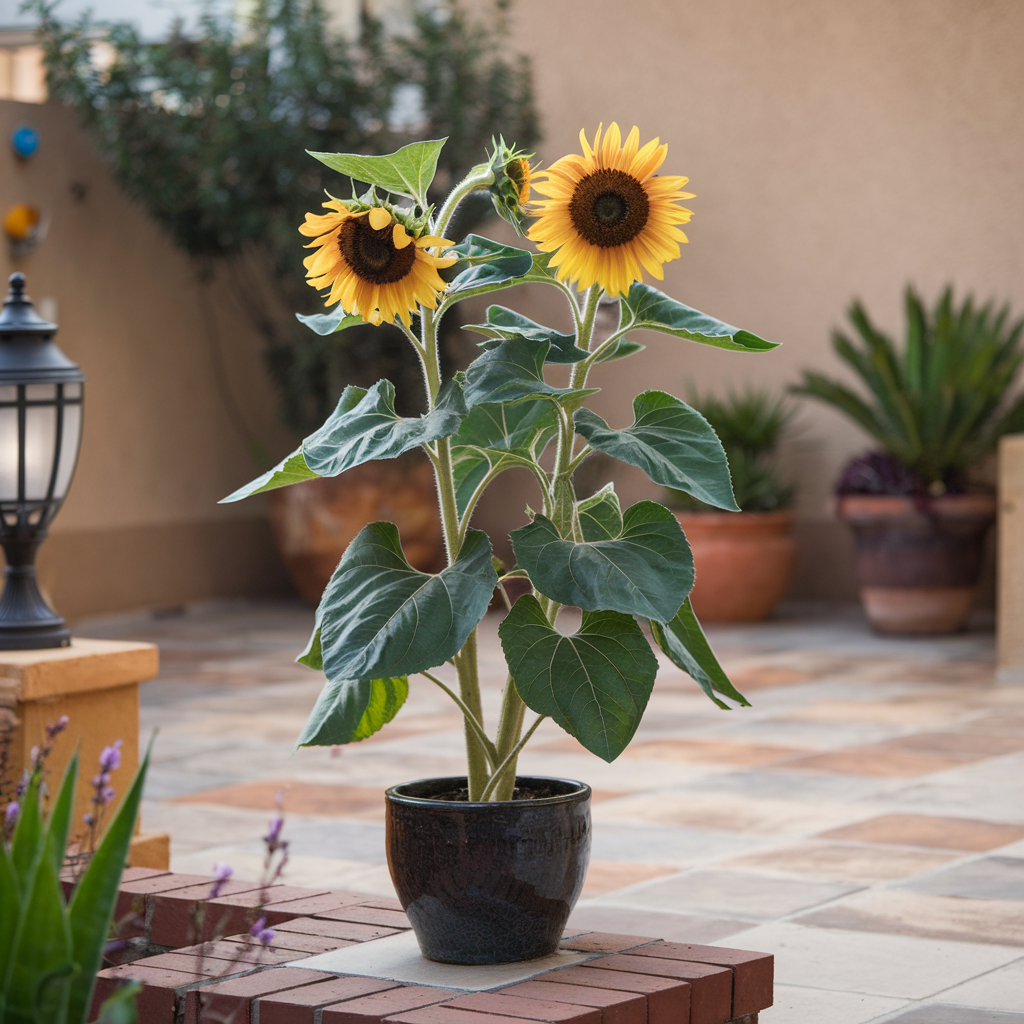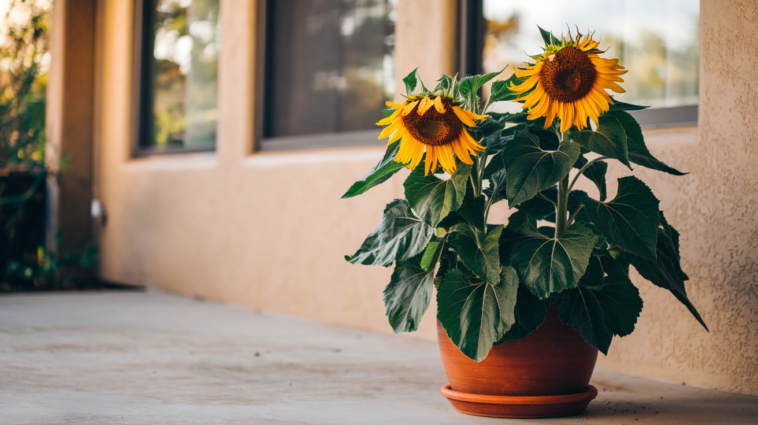Sunflowers are known for their bright, cheerful blooms and their ability to bring a touch of sunshine to any space. While they are often grown in gardens, sunflowers also thrive in containers, making them a perfect choice for balconies, patios, or small garden spaces.
Growing sunflowers in pots allows you to enjoy their beauty up close while giving you control over soil quality and placement. With the right care, potted sunflowers will grow strong and produce vibrant, long-lasting blooms. Here’s everything you need to know about growing and caring for sunflowers in pots.
Choosing the Right Sunflower Variety for Pots

Not all sunflowers are suitable for container gardening, as some can grow over 10 feet tall. For the best results, select compact or dwarf varieties that are well-suited for pots. Some of the best sunflower varieties for container gardening include:
- ‘Sunspot’ – A dwarf variety that grows about 2 feet tall, perfect for small pots.
- ‘Teddy Bear’ – A bushy, multi-bloom variety that stays around 2-3 feet tall.
- ‘Big Smile’ – A compact sunflower that reaches 12-18 inches, ideal for patios.
- ‘Elf’ – One of the smallest sunflower varieties, growing just 14 inches tall.
These smaller varieties fit well in containers and still provide the classic sunflower look without taking up too much space.
Selecting the Right Pot and Soil
Sunflowers have deep root systems, so choosing the right pot is essential for healthy growth. Use a container that is at least 12-16 inches deep and 12 inches wide to allow enough space for the roots to spread. If planting multiple sunflowers in one pot, choose a larger container to give each plant enough room to grow.
Drainage is crucial, so make sure the pot has drainage holes to prevent water from pooling at the bottom. A well-draining, nutrient-rich potting mix is ideal for sunflowers. You can enhance the soil by adding compost or organic matter to provide extra nutrients. Avoid using garden soil, as it can become compacted in pots and restrict root growth.
Planting Sunflowers in Pots
Sunflowers can be grown from seeds or transplanted seedlings, but they grow best when directly sown into the pot rather than being transplanted.
How to Plant Sunflower Seeds:
- Fill the pot with potting mix, leaving about an inch of space from the top.
- Plant the seeds ½ to 1 inch deep and space them 4-6 inches apart if growing multiple sunflowers in one container.
- Water the soil gently but thoroughly after planting.
- Place the pot in a warm, sunny location where it will receive plenty of light.
- Seeds typically germinate within 7-10 days. Once they sprout, thin them out if necessary, leaving the strongest seedlings.
If starting with young sunflower plants, transplant them carefully to avoid disturbing their roots.
Sunlight Requirements
Sunflowers are sun-loving plants and require at least 6-8 hours of direct sunlight daily. The more sunlight they receive, the healthier they will grow and the more vibrant their blooms will be.
Place your pots in a sunny spot such as a south-facing balcony, patio, or garden area. If growing sunflowers indoors, position them near a bright window or supplement with grow lights to ensure they get enough light.
Watering and Humidity
Sunflowers need consistent moisture, but they do not like to be overwatered. Water the plant when the top inch of soil feels dry. Deep watering is best, as it encourages strong root growth.
During hot weather, potted sunflowers may need daily watering, but always check the soil before watering to avoid making it too soggy. If the leaves start to droop, it’s a sign the plant needs more water.
Fertilizing Sunflowers
Since sunflowers are fast-growing plants, they benefit from regular feeding. Use a balanced liquid fertilizer (such as 10-10-10) every 2-3 weeks to promote healthy growth.
For larger, more vibrant flowers, you can use a phosphorus-rich fertilizer (such as a bloom booster). Organic options like compost tea or fish emulsion can also provide essential nutrients while improving soil health.
Supporting Tall Sunflowers
Even dwarf sunflower varieties can grow tall and top-heavy, so providing support is helpful. If your sunflowers reach over 2 feet tall, consider using a small stake or bamboo stick to help keep the stem upright.
Tie the plant loosely with a soft string or garden tie to avoid damaging the stem. This is especially important if your area experiences strong winds, as sunflowers can easily topple over in lightweight containers.
Deadheading and Pruning Sunflowers

Regularly removing faded flowers, known as deadheading, helps encourage continuous blooming. Simply snip off spent flowers with sharp scissors or pruning shears, cutting just above a healthy set of leaves.
If growing branching sunflower varieties, light pruning can encourage bushier growth and more blooms. However, single-stem sunflowers should not be pruned, as they produce only one flower per stalk.
Managing Pests and Diseases
Sunflowers are relatively pest-resistant, but they can sometimes attract aphids, spider mites, and caterpillars. To keep pests away:
- Inspect the leaves regularly and remove any visible insects by hand.
- Spray the plant with neem oil or insecticidal soap if pests become a problem.
- Encourage natural predators like ladybugs to help control aphids.
Fungal diseases such as powdery mildew can occur in humid conditions. To prevent this, ensure good air circulation around the plant and avoid overhead watering.
Overwintering Sunflowers
Sunflowers are typically grown as annuals, meaning they complete their life cycle in one season. However, if you want to save seeds for next year, allow the flower heads to dry on the plant. Once the back of the flower head turns brown, collect the seeds and store them in a dry place for future planting.
In warm climates, some sunflower varieties may self-seed and return the following year. If growing perennials like Maximilian sunflowers, you can bring the pot indoors during winter and keep it in a cool, dry place until spring.
Repotting Sunflowers
Sunflowers do not need frequent repotting since they are usually grown for a single season. However, if you start with a small pot and the plant outgrows it, you can carefully transfer it to a larger container for better root development.
Conclusion
Growing sunflowers in pots is an easy and rewarding way to add a splash of sunshine to your home or garden. By choosing the right variety, providing full sunlight, watering properly, and giving occasional support, you can enjoy vibrant sunflower blooms even in small spaces. Whether brightening up a balcony or standing tall on a patio, potted sunflowers are a beautiful and cheerful addition to any container garden.


